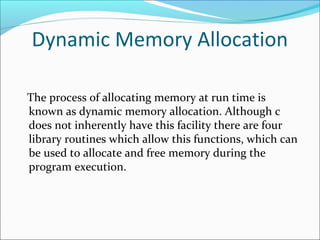
Memory allocation in c
- 1. Dynamic Memory Allocation The process of allocating memory at run time is known as dynamic memory allocation. Although c does not inherently have this facility there are four library routines which allow this functions, which can be used to allocate and free memory during the program execution.
- 2. Dynamic Memory Allocation Functions
- 3. malloc() A block mf memory may be allocated using the function malloc. The malloc function reserves a block of memory of specified size and returns a pointer of type void. This means that we can assign it to any type of pointer. It takes the following form: ptr=(cast-type*)malloc(byte-size); ptr is a pointer of type cast-type the malloc returns a pointer (of cast type) to an area of memory with size byte-size
- 4. malloc() Example Example: x=(int*)malloc(100*sizeof(int)); On successful execution of this statement a memory equivalent to 100 times the area of int bytes is reserved and the address of the first byte of memory allocated is assigned to the pointer x of type int.
- 5. Calloc Calloc is another memory allocation function that is normally used to request multiple blocks of storage each of the same size and then sets all bytes to zero. The general form of calloc is: ptr=(cast-type*) calloc(n,elem-size);
- 6. Calloc(Contd.) calloc() allocates contiguous space for n blocks each size of elements size bytes. All bytes are initialized to zero and a pointer to the first byte of the allocated region is returned. If there is not enough space a null pointer is returned.
- 7. free() Compile time storage of a variable is allocated and released by the system in accordance with its storage class. With the dynamic runtime allocation, it is our responsibility to release the space when it is not required. free(ptr); ptr is a pointer that has been created by using malloc or calloc
- 8. realloc The memory allocated by using calloc or malloc might be insufficient or excess sometimes in both the situations we can change the memory size already allocated with the help of the function realloc. This process is called reallocation of memory. The general statement of reallocation of memory is : ptr=realloc(ptr,newsize);
- 10. Introduction Files are places where data can be stored permanently. Some programs expect the same set of data to be fed as input every time it is run. Cumbersome. Better if the data are kept in a file, and the program reads from the file. Programs generating large volumes of output. Difficult to view on the screen. Better to store them in a file for later viewing/ processing
- 11. Basic File Operations Opening a file Reading data from a file Writing data to a file Closing a file
- 12. Opening a File A file must be “opened” before it can be used. FILE *fp; : fp = fopen (filename, mode); fp is declared as a pointer to the data type FILE. filename is a string - specifies the name of the file. fopen returns a pointer to the file which is used in all subsequent file operations. mode is a string which specifies the purpose of opening the file: “r” :: open the file for reading only “w” :: open the file for writing only “a” :: open the file for appending data to it
- 13. Closing a File After all operations on a file have been completed, it must be closed. Ensures that all file data stored in memory buffers are properly written to the file. General format: fclose (file_pointer) ; FILE *xyz ; xyz = fopen (“test”, “w”) ; ……. fclose (xyz) ;
- 14. Read/Write Operations on Files The simplest file input-output (I/O) function are getc and putc. getc is used to read a character from a file and return it. char ch; FILE *fp; ….. ch = getc (fp) ; getc will return an end-of-file marker EOF, when the end of the file has been reached. putc is used to write a character to a file. char ch; FILE *fp; …… putc (c, fp) ;
- 15. main() { FILE *in, *out ; char c ; in = fopen (“infile.dat”, “r”) ; out = fopen (“outfile.dat”, “w”) ; while ((c = getc (in)) != EOF) putc (toupper (c), out); fclose (in) ; fclose (out) ; }
- 16. Basic operations of files(Contd.) We can also use the file versions of scanf and printf, called fscanf and fprintf. General format: fscanf (file_pointer, control_string, list) ; fprintf (file_pointer, control_string, list) ; Examples: fscanf (fp, “%d %s %f”, &roll, dept_code, &cgpa) ; fprintf (out, “nThe result is: %d”, xyz) ;
- 17. Command line argument Command line arguments are parameters supplied to a program, when the program is invoked. How do these parameters get into the program? Every C program has a main function. main can take two arguments conventionally called argc and argv. Information regarding command line arguments are passed to the program through argc and argv.
- 19. C Preprocessor Overview Preprocessor Directives Conditional Compilation
- 20. Overview Six phases to execute C: 1. Edit 2. Preprocess 3. Compile 4. Link 5. Load 6. Execute
- 21. C Preprocessor All preprocessor directives begin with # Possible actions Inclusion of other files Definition of symbolic constants & macros Conditional compilation of program code Conditional compilation of preprocessor directives
- 22. Preprocessor Directives #define for symbolic constants #define identifier text Creates symbolic constants The “identifier” is replaced by “text” in the program Example #define PI 3.14 area = PI * radius * radius; Replaced by “area = 3.14 * radius * radius” by preprocessor before compilation
- 23. Conditional Compilation Controls the execution of preprocessor directives & compilation of code Define NULL, if it hasn’t been defined yet #if !defined(NULL) #define NULL 0 #endif Use to comment out code (for comments) #if 0 code prevented from compiling #endif
- 24. THANK YOU
